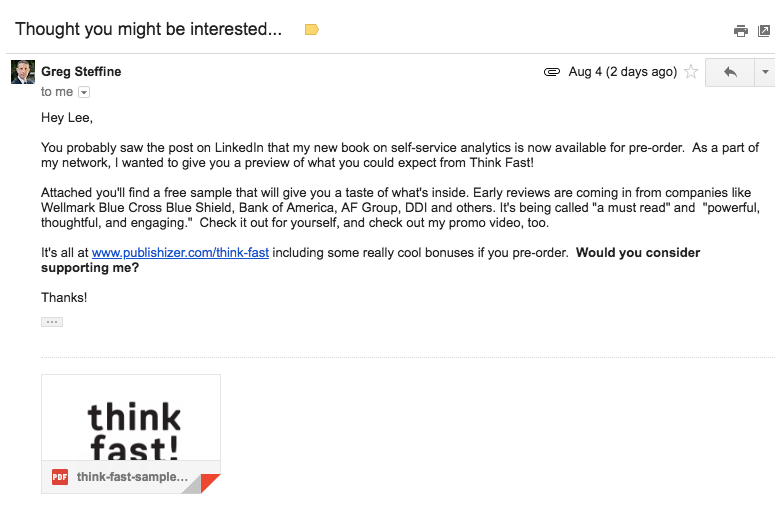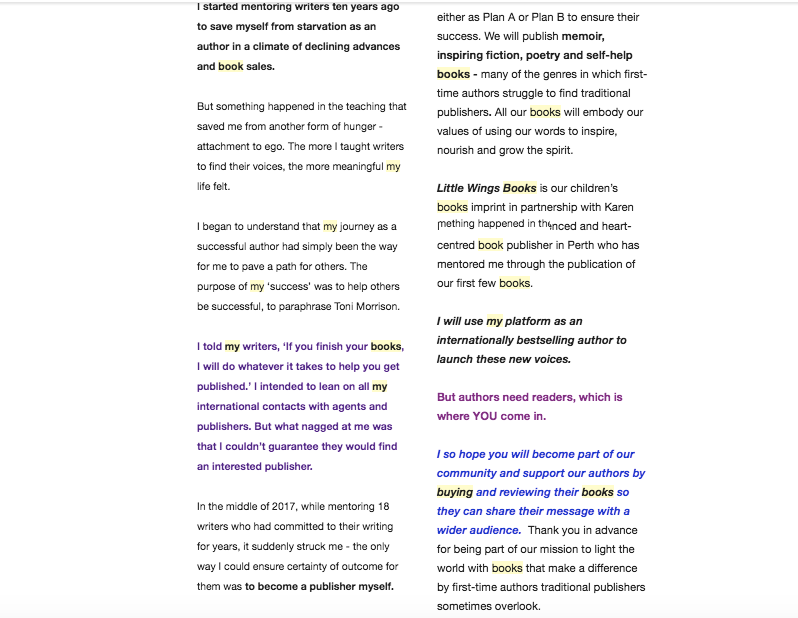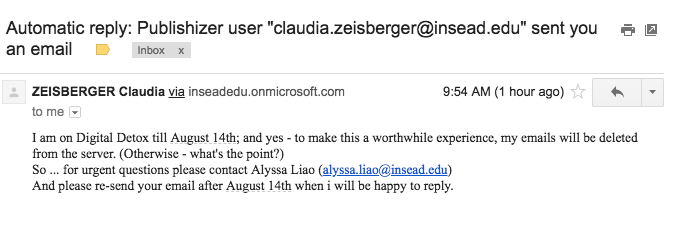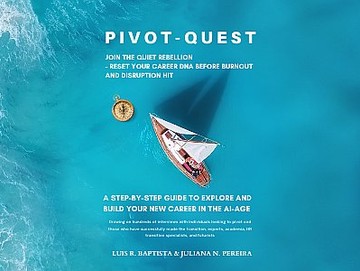Imagine walking up to someone on the street, telling them your life story, and then asking them for $50. Do you think they’d respond by pulling out their wallets? Or is it more likely they’d back away slowly, trying not to make eye contact?
It’s a pretty obvious answer, but most people don’t realize that the book pitches they’re sending essentially do the same thing. They share a lot of crap that nobody cares about — and then they have the audacity to ask the recipient to do them a favor or buy their book.
Trust me, it’s bad out there. I see about 100 book pitches a day. Most don’t do an amazing job getting results. It’s a bit heart-breaking when I see all the book pitches wrapped in bland marketing newsletters hit my inbox. That’s bad news for most people, but it’s good news for those of you who are motivated. If you’re willing to do things a little differently, there’s a lot you can do to write the kind of book pitches that actually get your story bought and shared.
Here’s how to do it.
#1. Keep it short
Repeat after me: no one needs more than 3–4 sentences to explain what they do or what your book is about — which is why it’s so frustrating when messages like this fill up my inbox:

If you’re currently sending 1,500-word pitches (which nobody is reading, by the way), cutting back to just 3–4 sentences can sound impossible. But think of it this way: you don’t need to propose marriage on the first date. All you need to do — on the date and in your email — is get someone interested in taking the next step with you.
Go back and look at your current pitch. Print it out, if it’s easier to hack apart that way. Now, cross out any words or sentences that aren’t explicitly necessary to getting someone to move forward with you. You probably need fewer sentences to do that than you think.
#2. Send from the right address
I know you‘re thinking of paying big bucks for a PR person or hiring an assistant to do the work for you. But guess what? If they send me book pitches instead of you, that’s an immediate sign that I should ignore your email.
It’s simple, really. When I get an email that’s obviously a book pitch, I know that the only intent is to get me to do something. When the message comes from you, personally — and it’s clear you’ve done your homework about who I am , how I know you, and you are genuine in telling me about your new book— that’s when I’m most likely to want to learn more.
(Oh, and to make matters worse, over 50% of authors who use paid advertising or PR people to send book pitches get almost zero return in book sales. There’s almost always a better way to spend your marketing dollars.)
#3. Make it topical and relevant to the recipient
Don’t take this blog post to mean you should email me about your book. If it’s already published I won’t be able to help you. Maybe I’d pay attention if you emailed me about book marketing, but many of the pitches I get are from a self-published author looking for a review. All you need to do is take a quick look at my blog and my website to see that I don’t work with authors like that. Now imagine how your readers would feel receiving an email like that.
Case in point:

If you did even the barest bones of research, you’d see from my Facebook profile that I’m into traveling. Or you’d see on my LinkedIn that I used to run a magazine. If you emailed me and said anything about editorial life or traveling, you’ve at least got my attention, and you’ve got 2–3 seconds to tell me what your pitch is about.
You don’t need to write up a full profile on the people you’re trying to reach. Just take two minutes to:
- Skim through their most recent blog posts
- See where they publish outside of their website (and what topics they cover)
- Check out their social profiles
- See who they’re connected to on LinkedIn
- Figure out their conversational style when communicating with others
Doing this shouldn’t take much time, but it’s a vital part of being able to personalize your book pitches appropriately.
#4. Don’t BCC
If you’re doing proper personalization, you shouldn’t ever be using BCC anyways, because your book pitch shouldn’t apply to multiple people at once.
But no matter what the circumstances are, don’t BCC people. It’s pure, utter laziness, and it’s immediately clear what you’re doing. Recipients are able to see that their name is in the BCC field, and they’re going to automatically know that you’ve emailed your pitch to a bunch of other people at the same time.
Really, you should be using Mailshake or YAMM or a similar tool when sending book pitches. But even if you’re not, do yourself a favor and send separate emails to different individuals so that the BCC field is unnecessary.
And while you’re at it pls also turn off your auto-responder. That’s just plain annoying — especially if you’re pitching your book. If I reply and get an auto-responder that’s where I stop responding to any more of your emails.
Here’s what I mean:

You’re kidding me right?
#5. Get their attention on social media first
We’ve known for a while that cold selling doesn’t always work, whether you’re talking about cold calling potential readers or reaching out to possible client or sponsor leads. But the solution isn’t to give up. In the context of book pitching, it’s to make sure you’re never reaching out to a cold prospect in the first place.
The way you do that is by getting the attention of the people you plan to send pitches to on social media first. Maybe you:
- Share content they’ve created with your audience
- Share content you’ve created; like a video
- Email a “thanks” when you enjoy something they’ve created
- Comment on their blog posts
- Add your insights to their work via comment or standalone post
- Interact with them on social media
- Send them a compliment
**Social media is not great for selling books. But it is great for awareness and engagement. You have to follow up personally and then get them to buy after you’ve already started the conversation. So if you PM me something like, “Hey, I just posted about my new book and saw you liked it,” you might just catch me in a conversational mood.
But it’s not about me. It’s about the person you’re reaching out to. Pay attention to the channels where they’re most active. If they’re most active on LinkedIn, reach out on LinkedIn. Ask for an email and follow up personally. Just remember the rules above. Sending them a compliment doesn’t mean you get to send them a 1,500-word boo pitch. It’s still too big of an ask.
#6. Focus on building a relationship
If you follow the tips I shared above, you’ll already be light-years ahead of the people out there spamming junk book pitches. But take it one step further. Don’t just try to warm up your contacts and followers with a little basic research. Actually try to build relationships with the people you’re reaching out to.
If a decent book pitch from someone I don’t know comes my way, I might pay attention to it. But if a request comes through from someone that’s in my network, I’m going to drop everything and see how I can help.
You don’t get there by liking a few of someone’s tweets or sending a quick message on LinkedIn (although that’s how a lot of my relationships have started out). Finding mutual common ground — maybe you’re into the same hobbies or grew up in the same area — isn’t enough either.
The best way I know of to build relationships is to find something you can do to help that person, and start there. Don’t ask for something first, and don’t make a surface-level offer (or worse, suggest something that benefits you more than the person you’re trying to connect with). Find something you can offer that’s genuinely valuable, and start from there.
This won’t work in all circumstances. Not everyone is looking to expand their network, and some people won’t be interested in the value you provide. But the more you invest in building genuine, mutually-beneficial relationships, the less you’ll have to worry about getting your book pitch noticed.
Got another tip to add to this list? Leave me a note below with your best suggestions, then check out these other great resources on book pitches:
16,871 Book Subscribers in 10 Minutes
How to Get 1,000 New Book Subscribers in 30 Days
How to Sell Your Book Using a Laptop
Cheers,


